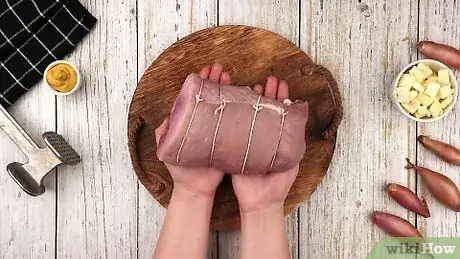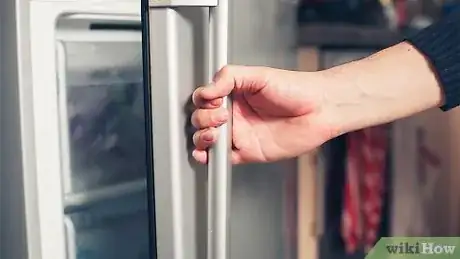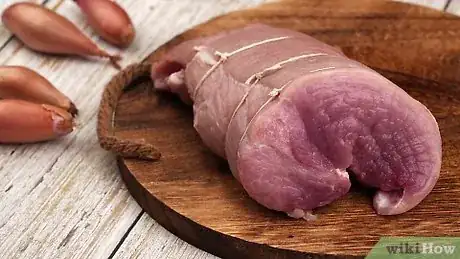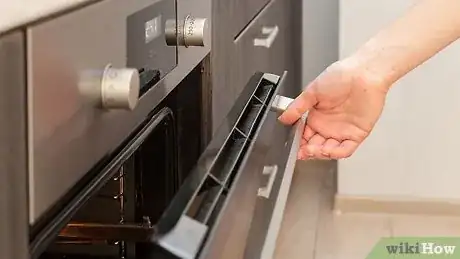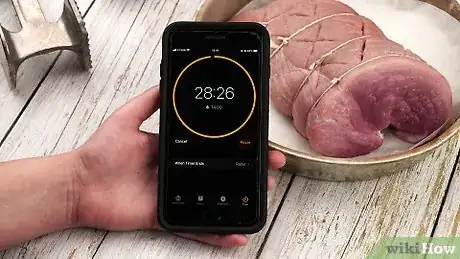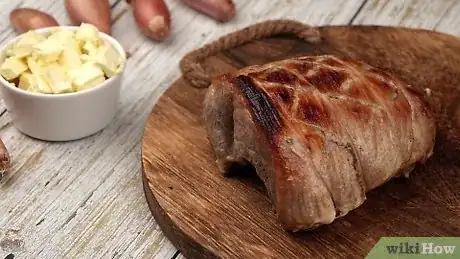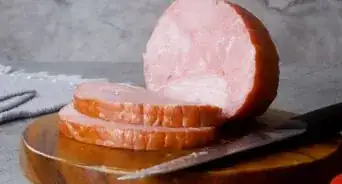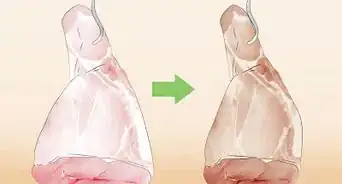This article was co-authored by Sasha Reyes. Chef Sasha Reyes is the Executive Chef and Owner of Artisan Personal Chefs. With over 20 years of food industry experience, she specializes in private dinner parties, custom sports nutrition plans for professional athletes, and cooking lessons. Chef Reyes graduated from Arizona Culinary Institute in 2011 with a degree in Culinary Arts, Baking, and Restaurant Management.
There are 7 references cited in this article, which can be found at the bottom of the page.
This article has been viewed 288,953 times.
Tender, juicy ham is the perfect main course for any holiday. It’s a versatile meat that isn’t difficult to cook, though the process requires a few hours’ time. Choose between uncooked or cured ham, depending on what flavor you like, and allow an hour and a half of cooking time. If you’d like, add a sweet or spicy glaze to complement the salty meat.
Steps
Prepping the Ham
-
1Choose a type of ham. You can buy fresh, uncooked ham, ham that has been preserved by curing it, and ham that has been preserved with smoke. Some ham is packed in juices, and some is packed dry. Each type is available bone-in or boneless, and you can buy it pre-sliced to make it easier to serve. If you're not sure what type of ham to buy, consider these popular choices, each of which has a different flavor:[1]
- Fresh or frozen uncured ham. This type of ham has never been cooked or cured. It has the light meaty flavor of fresh pork, similar to a pork roast or chop.
- Cured ham. Ham can be preserved by curing it with salt. Virginia ham, for example, is cured with a thick crust of salt. Salt is a distinguishing flavor in cured ham.
- Cured and smoked. Smoke is used to preserve this type of ham, lending it a very distinctive smoky flavor.
-
2Figure out what quantity you need. The cooking time will depend on how much meat you're cooking. Since hams take awhile to cook and make excellent leftovers, you might want to figure in a little more than you strictly need for one serving per person. Here's the breakdown for how much ham you need depending on what type you buy:[2]
- For boneless, you need ¼ to ⅓ pound per serving.
- For ham with a small bone, you need ⅓ to ½ pound per serving.
- For ham with a large bone, you need ¾ to 1 pound per serving.
Advertisement -
3Thaw frozen ham slowly. If you bought a frozen ham, it's important to thaw it the right way so it's not still frozen in the middle when you try to cook it. If this happens, the ham won't reach the correct internal temperature and may not be safe to eat. There are two ways to safely thaw a ham:[3]
- Refrigerator method: Place the frozen ham in the refrigerator the day before you plan to cook it. It will slowly thaw while remaining cold. Allow at least 24 hours for the ham to fully thaw.
- Cold water method: If you're shorter on time, you can submerge the ham in a large pot of cold water. Let the ham soak in the water for several hours, until it has fully thawed. Keep the water cold so the outer parts of the ham don't get too warm while the inside thaws.
-
4Consider soaking salty cured ham. Dry-cured ham is rubbed with salt to preserve it. Soaking for a few hours before cooking will take the edge off the salty taste and make it more palatable. To soak a ham, submerge it in water and place it in the refrigerator. Allow it to soak for four to eight hours, depending on how much salt you want it to retain.
-
5Bring your ham to room temperature before cooking. This ensures the entire ham will heat to the proper temperature. Remove the ham from the refrigerator two hours before cooking to bring it to room temperature.[4]
Baking the Ham
-
1Preheat the oven to 325 °F (163 °C). Whether you have cured or uncured ham, it needs to be cooked to an internal temperature of 160 °F (71 °C). Cooking it at 325 °F (163 °C) over the course of a few hours will ensure that the ham doesn't get dry on the outside while the inside cooks.
- If the ham was vacuum packed or canned, it was already fully cooked. That means you can eat it straight from the package or heat it to just 140 °F (60 °C) before eating.
-
2Place the ham in a large baking dish. Use a glass, ceramic or foil dish that's big enough to hold the ham and deep enough to hold the drippings.
-
3Score the ham if you plan to glaze it. Score through the skin and fat, but not the meat.[5] You can make a cross-hatched pattern for a pretty final effect. The scoring allows the glaze to seep deeper into the ham to flavor it down to the middle.
- If you have a pre-sliced ham, skip this step.
- If you want to season the ham with whole cloves, press a clove into each intersection made by the score marks.
-
4Cook for the right number of minutes per pound. You'll need to cook the ham until it reaches an internal temperature of 165 °F (74 °C). The amount of time you cook the ham depends on how much meat you're cooking and what type of ham you have. Check the temperature using a meat thermometer to make sure you don't over or undercook the ham. Here are the approximate cooking times:[6]
- For fresh ham: 22 to 28 minutes per pound.
- For smoked ham: 15 to 20 minutes per pound.
- For cured (country) ham: 20 to 25 minutes per pound.
-
5Make the glaze. You can make the glaze while the ham is cooking. Use whatever glaze recipe you like, whether it's spicy or sweet. Bring the glaze ingredients to a simmer on the stove, then reduce the mixture until it’s pourable but thick. To make a classic sweet honey glaze, use these ingredients:[7]
- 2 tablespoons mustard
- 1 cup firmly-packed brown sugar
- 1/2 cup honey
- 1/2 cup cider vinegar
- 1/2 cup butter
- 1 cup water
-
6Glaze the ham when the internal temperature reaches 135 °F (57 °C). This should happen within the last half our or so of cooking. Check the temperature with your meat thermometer, then carefully remove the ham from the oven to glaze it.
- Use a pastry brush to baste the ham, and try to work it into the grooves you scored.
- Return the ham to the oven and continue cooking until the internal temperature reaches 165 °F (74 °C).
- If you'd like, you can finish the ham under the broiler for the last 10 minutes.This creates a crunchy crust over the meat.
Serving the Ham
-
1Let it rest for 15 minutes after cooking. Remove the ham from the oven and set it on the counter to rest. Tent aluminum foil over the pan to trap the moisture inside. The ham's drippings will reabsorb into the meat while it rests, resulting in juicy, delectable ham. Skipping this step will result in dry ham.[8]
-
2Carve the ham. Use a very sharp carving knife to carve the ham after it's finished resting. Using a blunt knife is dangerous, since it could easily slip off the meat. Sharpen your knife using a whetstone or knife sharpener, then carve the meat as follows:
- Trim off a few slices off the narrower end of the ham.
- Set the ham on the flat part where you cut off the slices. This will create a stable base.
- Make horizontal cuts across the side of the ham, from the outside to the bone.
- Slice vertically along the bone so the slices drop to the cutting board.
- Repeat with the other side of the ham.
- Don't throw the ham bone away! It makes a delicious soup base.
-
3Store the leftover ham. After serving up your feast, save the rest of the ham for later. It will keep in the refrigerator for up to a week. You can also place ham slices in a freezer safe container and freeze the ham for up to a month. Use the leftover ham to make delicious sandwiches and one of these classic dishes:
Community Q&A
-
QuestionCan I use a boneless ham to make a boiled dinner?
 Community AnswerYes. It is easier to slice, but corned beef is better for a boiled dinner.
Community AnswerYes. It is easier to slice, but corned beef is better for a boiled dinner. -
QuestionShould I put any water in the roasting pan, and do I cover the pan?
 Community AnswerYou don't have to put any water into the pan, but you should cover it. This will help keep the moisture in the pan. The juices from the ham will provide enough moisture to keep the ham moist and use for basting during the cooking process.
Community AnswerYou don't have to put any water into the pan, but you should cover it. This will help keep the moisture in the pan. The juices from the ham will provide enough moisture to keep the ham moist and use for basting during the cooking process. -
QuestionDo I need to boil my ham that has a bone in it?
 Community AnswerNo, you don't have too. Just properly season it and place it in the oven.
Community AnswerNo, you don't have too. Just properly season it and place it in the oven.
References
- ↑ https://www.myrecipes.com/extracrispy/every-type-of-american-ham-explained
- ↑ http://whatscookingamerica.net/Pork/Ham101.htm
- ↑ https://www.stilltasty.com/articles/view/87
- ↑ https://www.recipetips.com/kitchen-tips/t--749/roasting-ham.asp
- ↑ http://whatscookingamerica.net/Pork/Ham101.htm
- ↑ https://www.foodsafety.gov/keep/charts/hamcookingchart.html
- ↑ https://therecipecritic.com/honey-glazed-ham/
- ↑ https://www.bonappetit.com/test-kitchen/common-mistakes/article/avoid-these-6-common-mistakes-with-your-easter-ham
About This Article
To cook a ham, preheat your oven to 325 °F and place the defrosted ham in a large baking dish. If you plan on glazing the ham, use a knife to score the top of the ham in a cross-hatch pattern. Then, place the ham in the oven to cook for 20 minutes per 1 pound. Once the ham has been in the oven for its full cook time, insert an instant thermometer to ensure that the meat has reached an internal temperature of 165 °F. Finally, let the ham rest outside of the oven for 15 minutes before serving. For tips on how to serve your tasty ham, read on!

